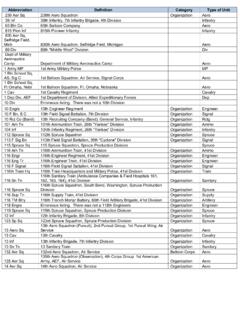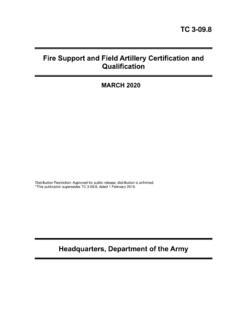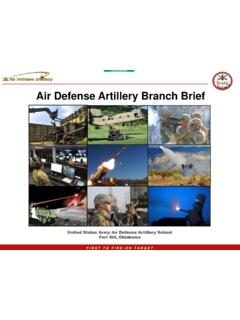Transcription of Rules of Play
1 2021 GMT Games, LLC Box 1308, Hanford, CA 93232-1308 Rules of Play Living Rules / / Changes in blueTable of Introduction .. The Game Turn .. Operations .. Movement .. Terrain .. Support (Firepower) .. brigade /Regiment Formations .. Limited Intelligence .. The ARVN .. The Seasonal Interphase .. Pacification .. Strategic Bombing .. South Vietnamese Morale and Commitment .. Reinforcements ..332 2021 GMT Games, LLCVIETNAM 1965-1975 Living Rules / / Changes in IntroductionVietnam: 1965-1975 simulates the military and political aspects of the United States involvement in Vietnam from 1965 on. One player controls the resources of the United States, South Viet-nam, and their allies. The other player controls the National Liberation Front of South Vietnam and the Democratic Republic of (North) Vietnam. A variety of scenarios recreating both individual operations and grand strategy of the war are provided. The shorter Operational scenarios can be played in an evening, while a campaign game (simulating the entire war) can take several hundred hours to play to edition incorporates all known errata and clarifies Rules and concepts with input from the game s original designer and the years of discussions on various online forums.
2 These clari-fied Rules have been marked with this symbol: . The RulesThe Rules to Vietnam: 1965-1975 are divided into consecu-tively numbered Sections (major topics, eg. ), some of which are further divided into Subsections (secondary topics under the major headings, eg. ). Numerical references to sections and subsections are used throughout the Rules for clarity and The MapThe map sheets depict South Vietnam (SVN) and adjacent areas of Laos, Cambodia, and North Vietnam (NVN). It has been produced in three sections. The maps should be oriented in the same direction and assembled according to the follow-ing diagram:Some of the scenarios will require only one or two significant locations and terrain features rele-vant to the war are depicted on the map. A hexagonal grid has been superimposed over the terrain to regulate movement and other game functions. Each hexagon (or hex ) is numbered for easy borders and boundaries are printed on the map (and generally run through hexes rather than along hexsides) and are explained in greater detail later [ ].
3 Corps ZonesThe map of South Vietnam is divided into four Corps Zones (I, II, III, & IV). These are used for various game functions such as ARVN Leader Sphere of Influence, ARVN Effectiveness, and ARVN divisional command and RegionsSouth Vietnam is further divided into regions. Most regions are individual provinces or municipali ties. A few are composites of several low-population provinces. Each region has a population ranging from 4 to 15 (each point representing approximately 50,000 people). Regions are primarily important for Free-Fire and to know where the regions are on the map can take a while, as the names can be confusing to those unfamiliar with the geography of Vietnam. To facilitate matters, the regions are numbered and re-created in outline on the central map. The numbers are broken down by Corps Zone ( , Qu ng Tr is Region I-1 because it is the first region in the I Corps zone). The number codes have no special significance to play; they are merely provided as an Zone IVCorps Zone IIIC orps Zone IICorps Zone I3 2021 GMT Games, LLCVIETNAM 1965-1975 Living Rules / / Changes in The Playing PiecesThe cardboard counters (called units when referring to mili-tary pieces) represent military formations and support units that participated, or might have participated, in the historical campaign.
4 For ARVN and NVA units, the front represents the unaugmented values and the back represents the augmented values [ ; ]. Various informational and memory aid marker counters are also example playing pieces are representative of the units in the Unit Designations and SubordinationUnits use the designations on the counter to determine subor-dination. Unit subordination is depicted in several ways. The color in the unit type symbol denotes that it is a subordinate unit or HQ with subordinates. For example, the 1/1 Battalion to the left shows that the 1st Battalion is subordinate to the 1st brigade (1/1 in the upper left) of the 1st Cavalry Division (1C in the upper right). The 1st Division HQ has its division insignia in the upper right denoting that it is not, itself, subordinate to any other HQ. The white unit type box of the artillery unit denotes that the unit is not a subordinate Charts and TablesSeveral charts and tables are used in Vietnam to condense and simplify various game functions.
5 These include the Terrain Effects Chart (TEC), Combat Results Table (CRT), Pacification Table, Strategic Bombing Table, SVN Leader Loyalty Table, Morale Chart, Unit Cost Chart, and Blockade Chart. Some of these charts and tables are printed on the map and some are printed on Player Aid Tracks and DisplaysSeveral tracks and displays are provided as aids to record keeping. These include the Game Turn Track, the General Record Track, the SVN Leader Display, and the Ho Chi Minh Trail Track. A separate Game Record Track player aid card is included for players to use when the scenario doesn t use maps containing the entire on-map markers indicate the Year and Current Season on the Game Turn Track. There are two game turns each season, so the face of the Season marker (as well as the box it occupies) shows whether the first or second turn of the season is in General Record Track is used to record constantly chang-ing quantities: air support remaining, unused helicopter transport, riverine transport points, replacements, etc.
6 The track is numbered from 0 to 99, and by flipping over a marker to its reverse (+100) side, values from 100 to 199 can be SVN Leader Display is used to record the shifting loyal-ties of the upper echelon of South Vietnamese leadership. The Ho Chi Minh Trail Track is used to record the status of the Trail: how well-developed the infiltration routes are, and what damage they have sustained because of US Record SheetsWritten records must be kept on certain information relevant to the play of the game. The NLF, SVN, and US each use a sepa-rate record sheet for tracking information. The NLF player may ask to see the Allied player s sheets at any time; the Allied player cannot ask to see the NLF sheet. These sheets are coded to indicate when during the Seasonal Interphase each section is to be filled in. For example, GT-1 indicates that a section is to be filled in during the first phase of the game turn (GT); S-5D 106/27060+331/11C8 Ground Combat UnitNaval UnitSVN LeaderCounter ColorsGround Combat StrengthPursuit ModifierMovement Point Allowance(Yellow MPA# Inherently Airmobile) Ground-BoundUnit SizeUnit TypeArtillery StrengthExerts no ZOCD ivision BadgeArtillery RangeLeader Name/LetterEffectiveness RatingUS MoraleModifierSVN Morale ModifierSupport RangeSupport StrengthIndicates status in the US Navy Holding BoxBackFront(blank)Unit Designation(Battalion/ brigade or Regiment)(Division)(white line frame)(MPA# in white box)Cruiser6 CCUnit SizesUnit TypesII BattalionIII RegimentX BrigadeXX DivisionInfantryMarineAirborneAirmobileR angerHeadquartersArmored CavalryArmoredArmored ArtilleryArtilleryMechanized HQAirmobile/Mech HQUS ArmyUS Marine CorpsUS NavyARVNANZACA ustraliaKoreaPhilippinesThailandNVAViet CongAlliesAllies (FWA)
7 NLF4 2021 GMT Games, LLCVIETNAM 1965-1975 Living Rules / / Changes in blueindicates that the section should be filled in during the fourth segment (D) of the fifth phase (5) of the seasonal interphase (S) (see , Game Turn Sequence of Play; 11, Seasonal Interphase; and the Sequence of Play player aid card). The NLF and SVN sheets are unnecessary in Operational scenarios, as is most of the US sheet. There is a detailed explanation for how to use the sheets in the Playbook [PB ].In the Campaign Scenarios, both players also jointly manage recording Population Control. There are two methods: the Controlled Population Display on the map and the Population Control Sheet. Players can use either or both. A Population Control Reference Sheet is on the Seasonal Interphase Player Aid Card, and contains the Pacification Table, Population Shift Scale, and a summary of procedures and modifications relevant to Pacification [ ]. The Record Sheets provided with the game are samples only and should not be written on.
8 The players should make copies of these sheets before beginning play, or download electronic copies for printing from ScaleEach hex represents an area 6 miles (about 10 kilometers) across. There are four seasons (Spring, Summer, Fall, and Winter) per year and two game turns per AbbreviationsSeveral abbreviations are used throughout the Rules and on some of the counters:RulesCountersARVN: Army of the Republic of (South) VietnamF WA : Free World AlliesNLF: National Liberation FrontN VA : North Vietnam ArmyNVN: North VietnamR F: Regional ForcesSV N: South VietnamUS: United StatesVC: Viet CongZOC: Zone of ControlA: ArmorAT F: Australian Task ForceANZ: Australia-New Zealand Army CorpsBP: Black PanthersCAP: CapitalCAG: Civic Action GroupCav: CavalryM: MarineA: AirborneQC: Queen s Cobras1C: 1st Cavalry (Airmobile) The SidesThe two sides in the game are the Allies or Allied (see Design Note below) representing the US, ARVN, FWA and the NLF representing the NVA and VC.
9 When a rule applies to a side, the more general term will be used: Allied or NLF. When a rule applies to the specific units of a side, the more specific term will be used: US, ARVN, FWA, NVA, Note: The term, Allied, is not meant to imply an equal partnership between the US, FWA, and ARVN. This was very much a US-controlled conflict. Its use within the Rules is exclusively meant as a short-hand convenience when speaking to the general versus the The Game TurnIn a real military campaign, thousands of things happen at once. The players, however, have only four hands and two minds; they cannot manipulate all their units and make all relevant decisions simultaneously. The following sequence has been designed to recreate the feel of the conflict in Vietnam, and the advantages and disadvantages of each : 1965-1975 is played in successive Game Turns. Each game turn is composed of several Phases, some of which are further subdivided into Segments. During each game turn, the players maneuver their units and engage in combat.
10 This frame-work of game turns, phases, and segments provides a logical order in which these actions are Game Turn Sequence of PlayGame Turn (conduct twice each season)1. Support PhaseThe Allied player indicates available air, airmobile, and river-ine support on his Record Sheet, and places the corresponding markers on the General Record Special Operations Designation PhaseThe Allied player assigns units to Hold or Patrol Operations. The NLF player then does the Strategic Movement PhaseThe FWA player may conduct Security Operations and employ Strategic and Naval Operations PhaseA. Designation SegmentThe NLF player decides whether he or the Allied player will conduct an Operation. The indicated (Operating) player then states the type of operation he will conduct (Search and Destroy [ ], Clear and Secure [ ], Hold [3. 3. 1], Patrol [3. 3. 2], Security [ ] Naval Transport [ ], Strategic Movement [ ], or Bombardment [3. 7 ]) and which units are assigned to the operation [ ].






